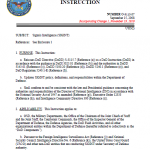GCHQ Bude, formerly known as the the GCHQ Composite Signals Organisation Station (CSOS) Morwenstow, is a satellite ground station located on the north Cornwall coast between the small villages of Morwenstow and Coombe, UK operated by the British signals intelligence service (GCHQ) on the site of the former World War II airfield, RAF Cleave. Staff are drawn from GCHQ (UK) and the NSA (U.S.) and the station is operated under the UKUSA agreement, gathering data for the ECHELON signals intelligence (SIGINT) network. Comparable stations in operation include Menwith Hill (UK), Sugar Grove (West Virginia, U.S.), Yakima (Washington, U.S.), Sabana Seca (Puerto Rico), Misawa (Japan), Pine Gap (Australia), Geraldton (Australia), GCSB Waihopai (New Zealand) and GCSB Tangimoana (New Zealand) that cover other INTELSAT areas such as South America and the Pacific Ocean. GCHQ Bude is located about 100 km from the commercially operated Goonhilly Satellite Earth Station that handles civilian communications which was closed in 2008.
Read more →

